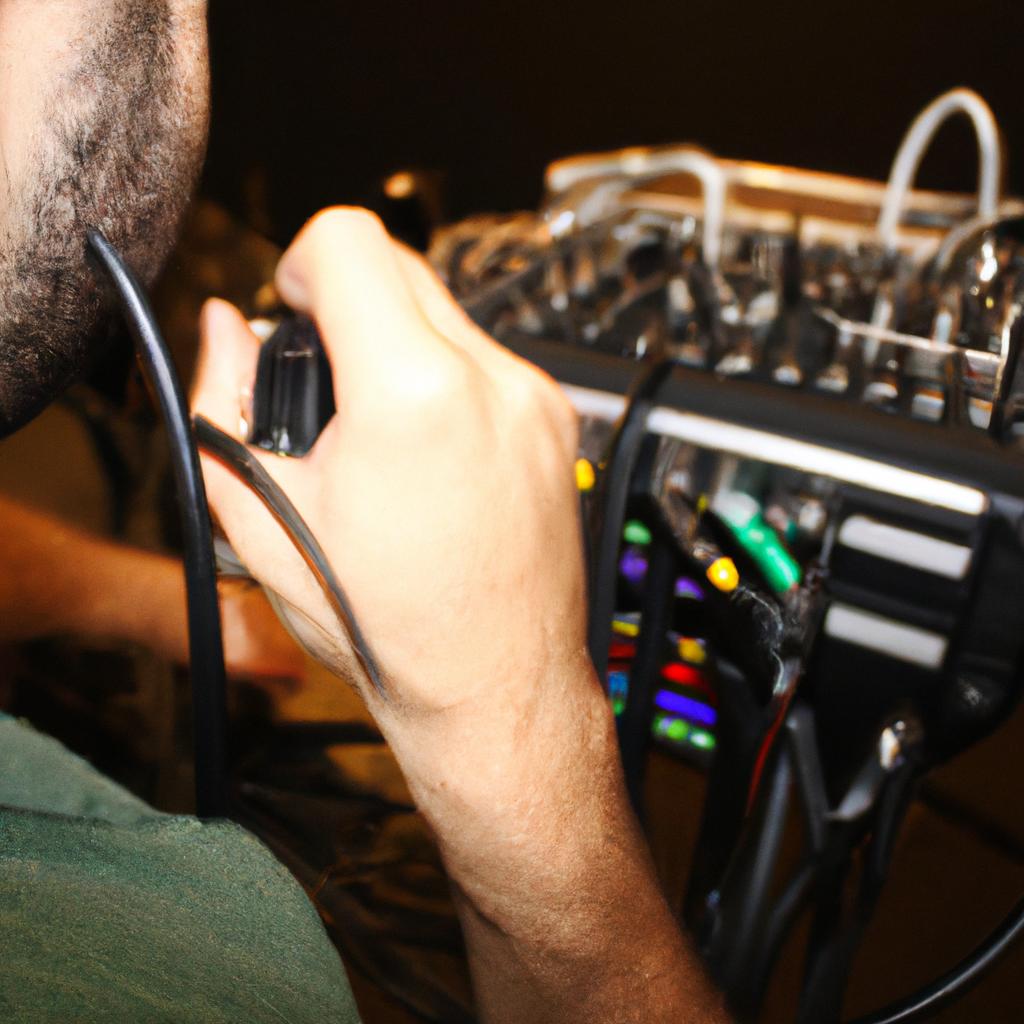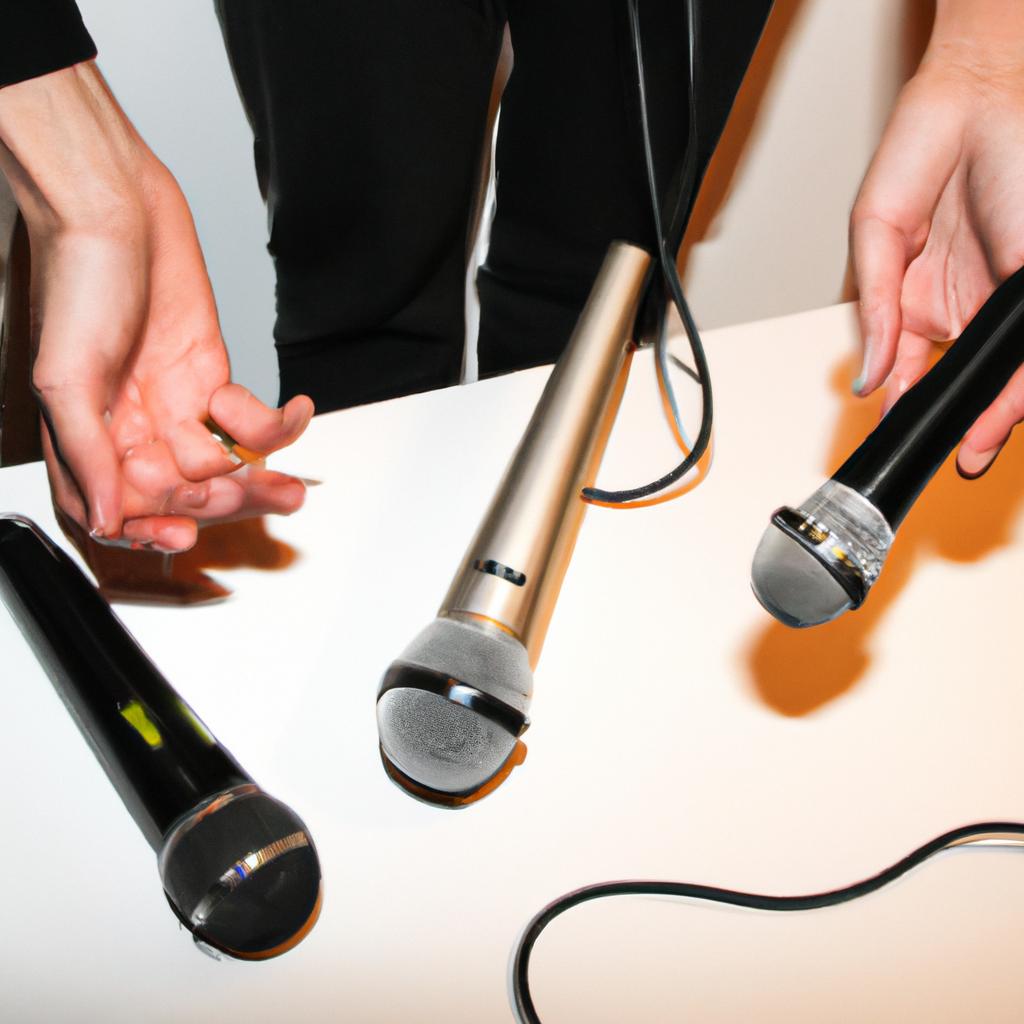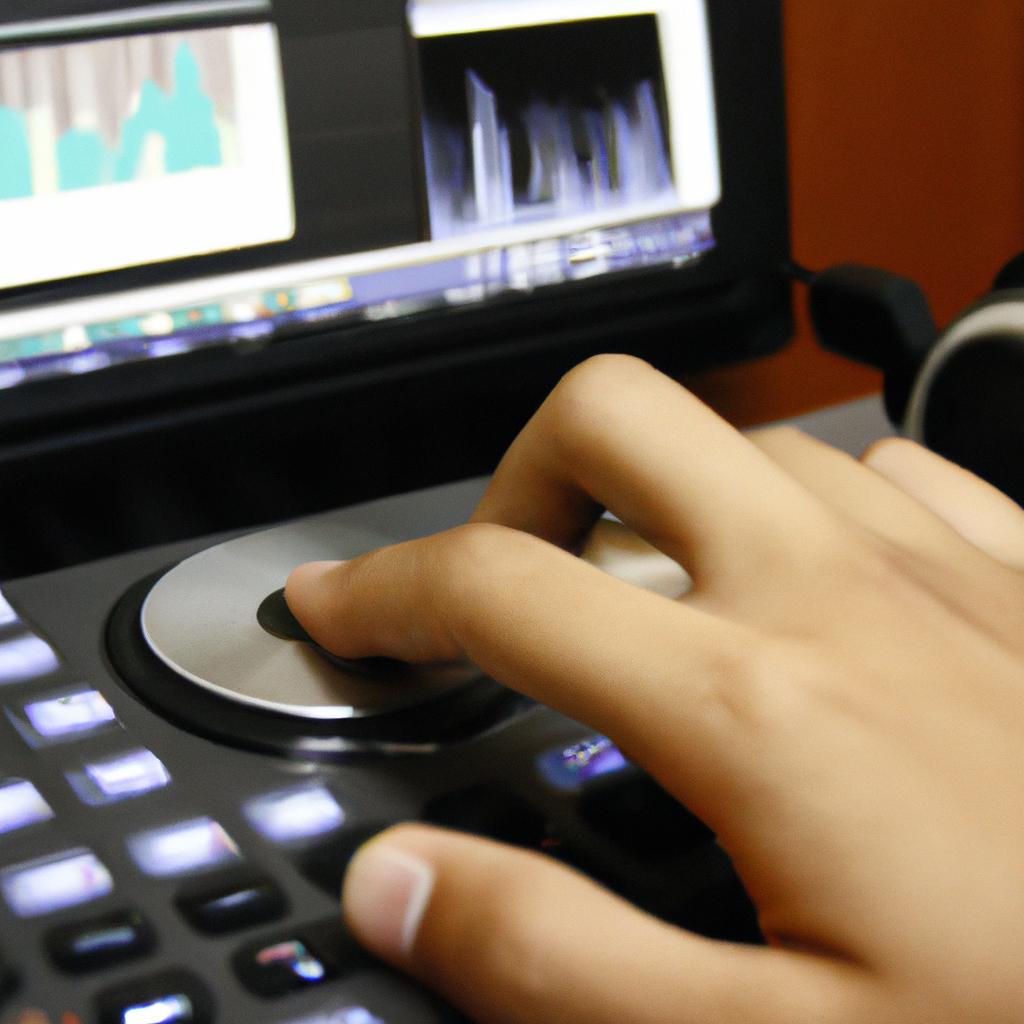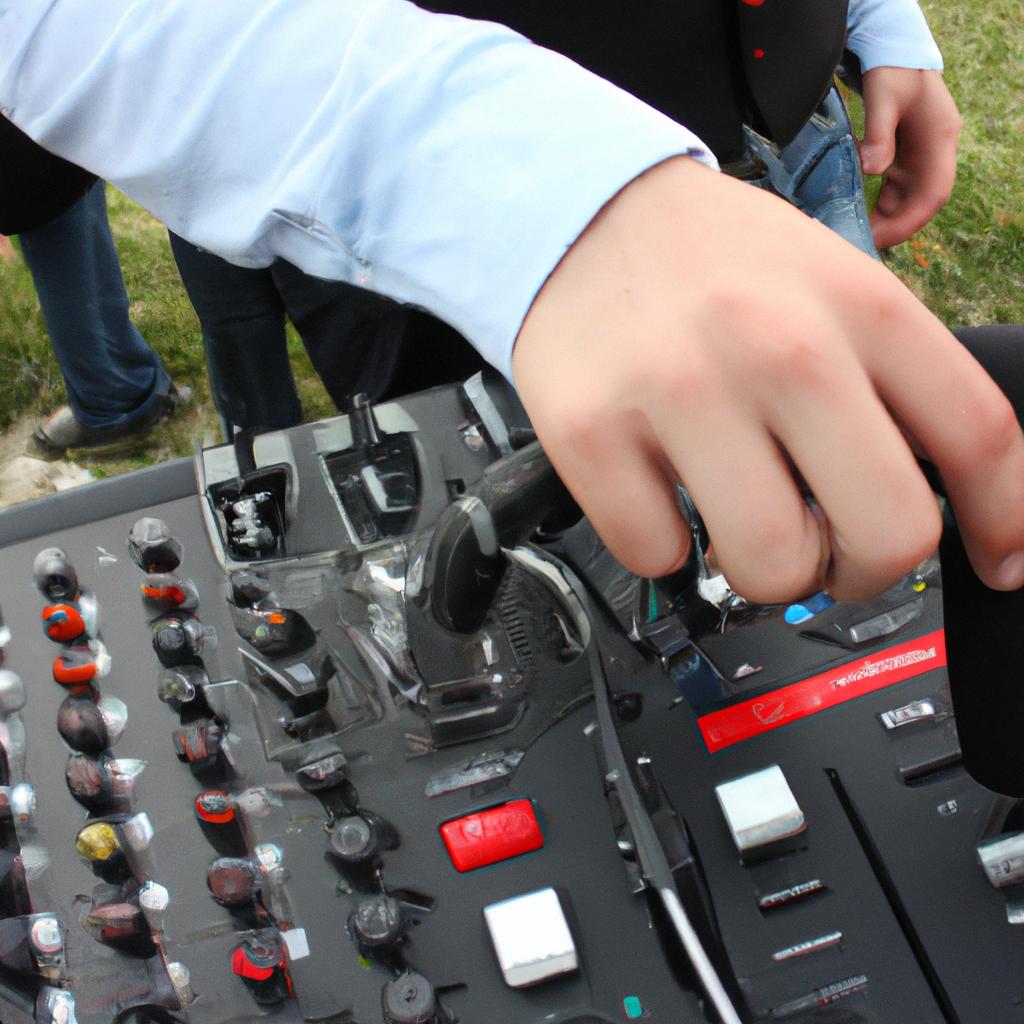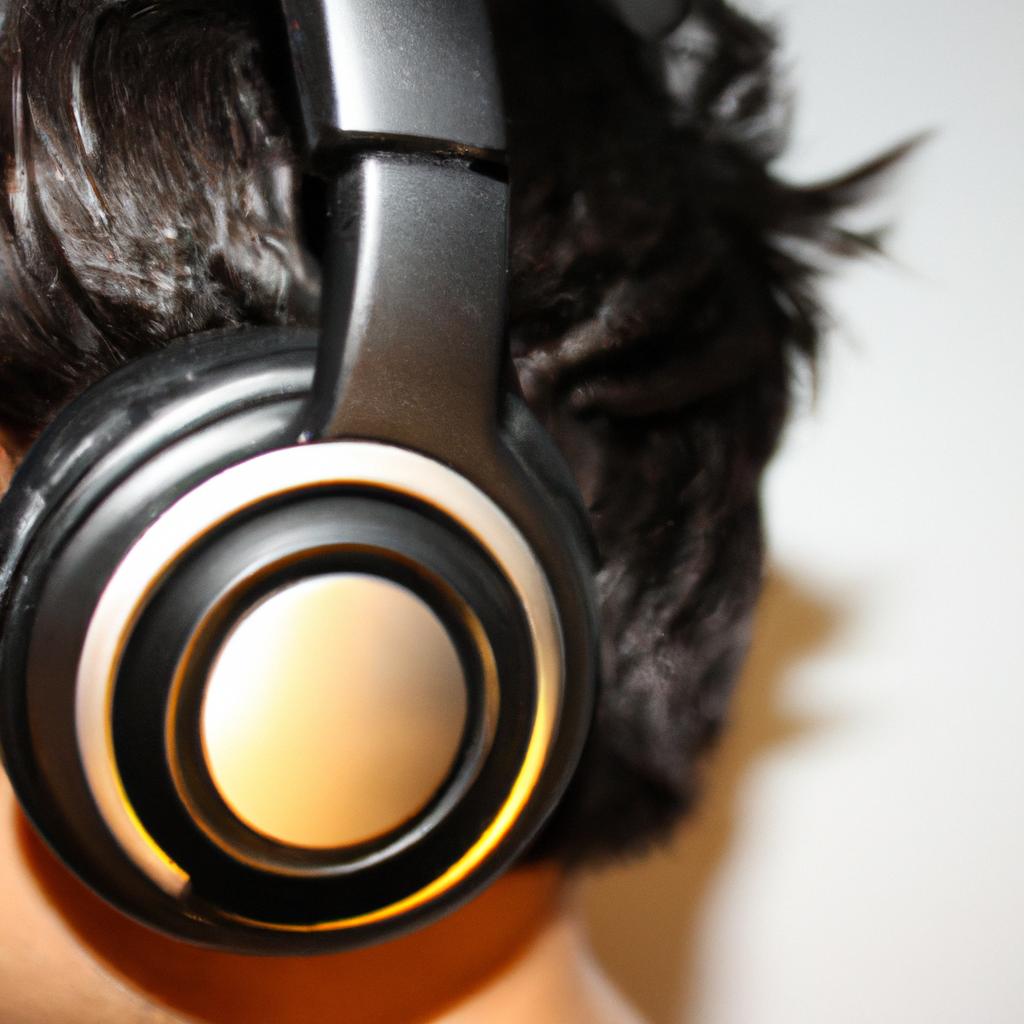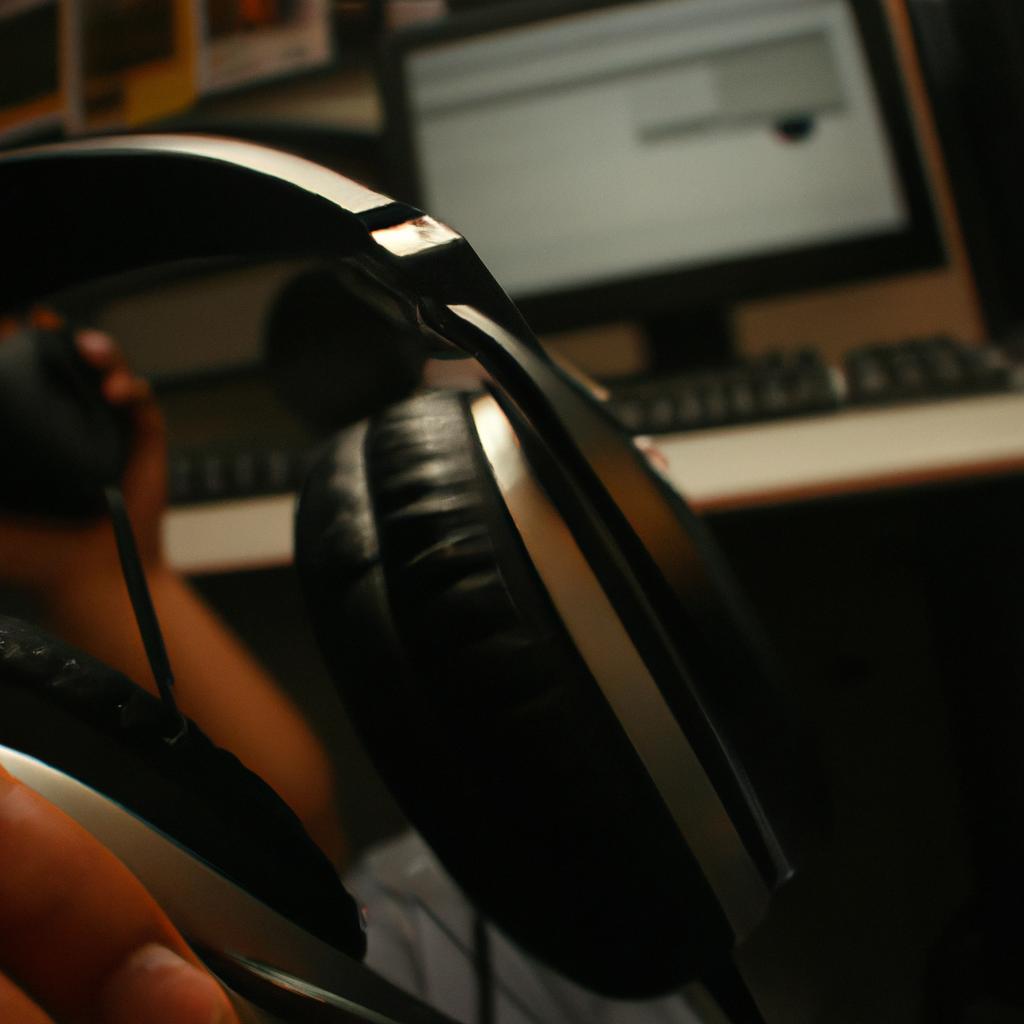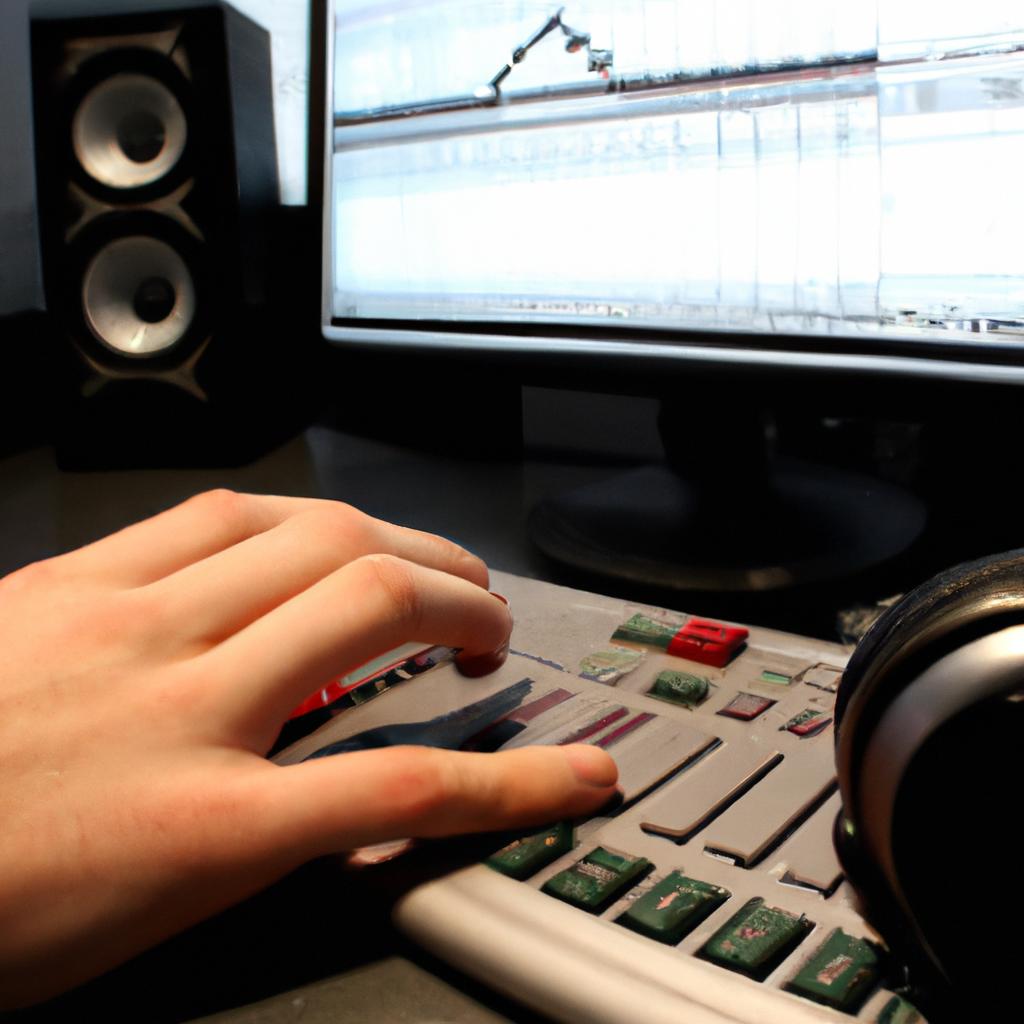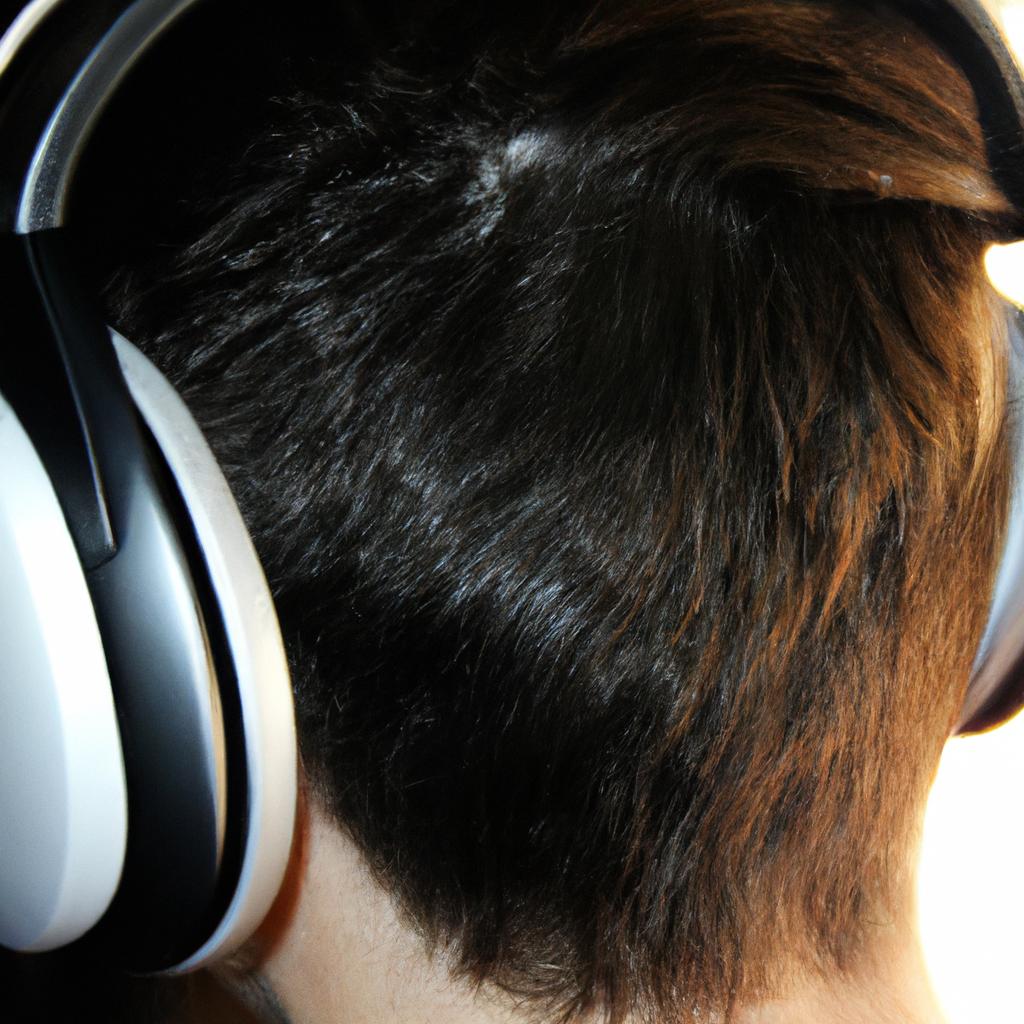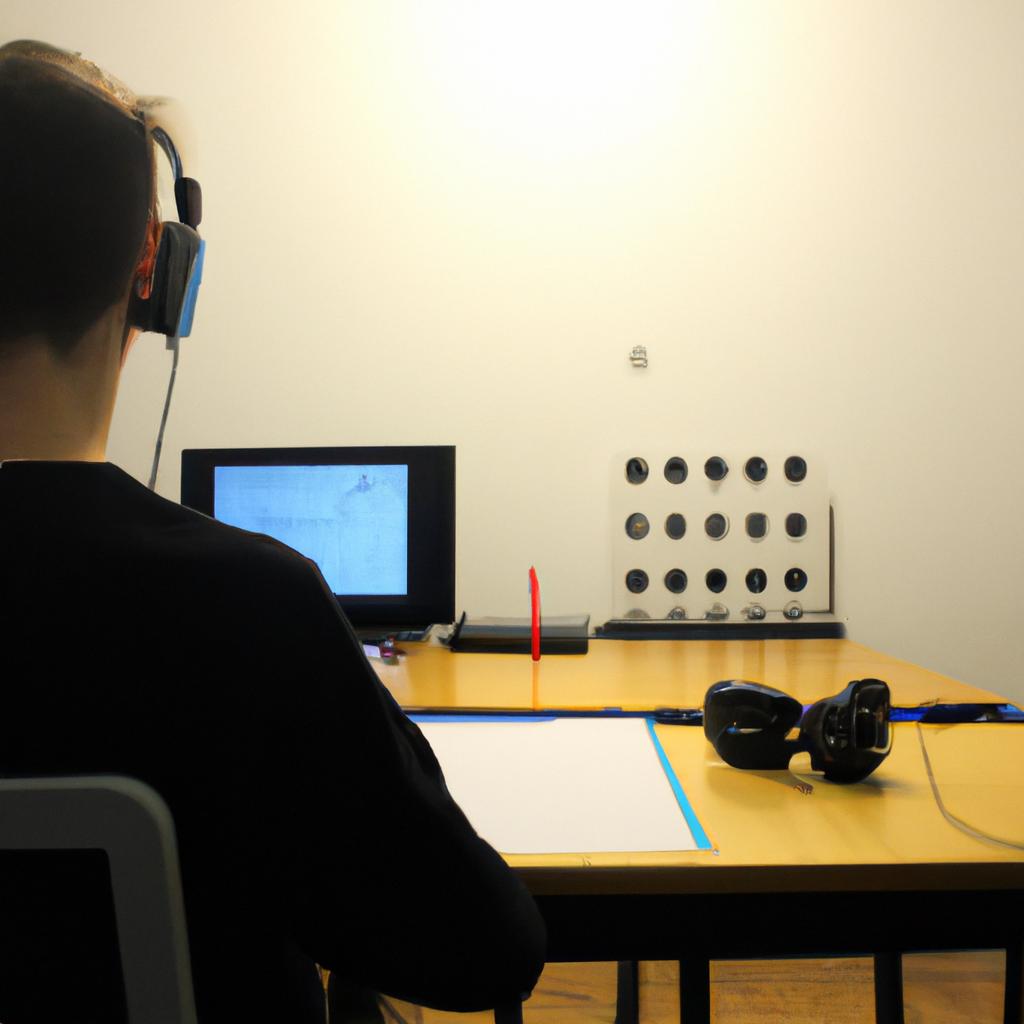Audio recording plays a crucial role in capturing and preserving sound within the context of both sound and vision. Whether it is used in film production, music composition, or podcasting, audio recording serves as an essential tool for enhancing the overall sensory experience. For instance, imagine watching a gripping suspense movie where every creak of a door or whisper in the dark adds an extra layer of tension to the scene. This heightened sense of realism can only be achieved through meticulous audio recording techniques that capture even the subtlest nuances of sound.
In addition to its aesthetic value, audio recording also holds immense practical significance. In professional settings such as radio broadcasting or conference recordings, accurate and clear audio reproduction is vital for effective communication. Imagine attending a seminar where the speaker’s words are muffled or distorted due to poor microphone placement or low-quality equipment. Such issues not only hinder comprehension but also diminish the impact of the message being conveyed. Therefore, understanding different aspects of audio recording – from microphone selection to post-production editing techniques – becomes imperative for anyone dealing with sound and vision industries.
This article aims to provide an informative insight into the world of audio recording by exploring various concepts, technologies, and practices associated with this field. By delving into topics like microphone types and characteristics, audio recording techniques, signal processing, and post-production editing, readers will gain a comprehensive understanding of the intricacies involved in capturing high-quality audio.
One of the fundamental aspects of audio recording is microphone selection. Different types of microphones, such as condenser, dynamic, and ribbon microphones, have their own unique characteristics that make them suitable for specific recording scenarios. Understanding these differences can help individuals choose the right microphone for their intended purpose and achieve optimal sound quality.
Furthermore, mastering various audio recording techniques is essential for capturing sound accurately. Techniques like close-miking, stereo miking, and ambient recording enable artists and engineers to create immersive sonic experiences by manipulating the spatial perception of sound. Additionally, understanding concepts like phase cancellation and proper microphone placement can help minimize unwanted noise and ensure a clean recording.
Signal processing plays a crucial role in shaping the recorded audio. Equalization (EQ), compression, reverb, and other effects are used during the mixing process to enhance or modify certain aspects of the sound. Knowing how to utilize these tools effectively allows artists and engineers to achieve desired tonal characteristics or create specific moods within their recordings.
Finally, post-production editing techniques further refine the recorded audio. Tasks like removing background noise or unwanted artifacts, adjusting volume levels, synchronizing audio with visual elements in film production, or adding special effects require specialized software tools. Familiarity with these editing techniques enables individuals to polish their recordings and produce professional-quality results.
In conclusion, audio recording serves as an indispensable tool in various industries related to sound and vision. Whether it’s enhancing cinematic experiences through realistic soundscapes or ensuring effective communication in professional settings, understanding different aspects of audio recording is crucial. By exploring topics such as microphone selection, recording techniques,
signal processing, and post-production editing techniques highlighted in this article{finish the sentence}.
Types of Microphones
To truly understand the intricacies of audio recording, it is crucial to explore the various types of microphones that are commonly used in this field. By examining these different microphone options and their respective functionalities, we can gain valuable insight into how sound is captured and reproduced.
Let’s begin by considering an example scenario: imagine a live concert where multiple musicians are performing on stage. In such a dynamic environment, capturing each instrument with precision requires careful selection of the appropriate microphone type for each specific source.
One common distinction among microphones lies in their polar patterns – the directional sensitivity they exhibit towards incoming sound waves. This feature determines not only what the microphone picks up but also what it rejects. To illustrate further, let us take a look at four distinct polar patterns:
- Cardioid: This pattern focuses on capturing sound from one primary direction while minimizing noise from other angles. It is often employed during live performances or studio recordings when isolating a particular voice or instrument becomes essential.
- Omnidirectional: As its name suggests, this pattern captures sound equally from all directions. Omnidirectional microphones excel in situations where ambient sounds need to be recorded alongside the main audio source.
- Bidirectional: Also known as figure-eight pattern, this type records sound primarily from both front and back while rejecting any noise originating from either side. Bidirectional microphones prove useful during interviews or duets where two sources face each other.
- Supercardioid/Hypercardioid: These patterns offer narrower pickup areas compared to cardioid mics, resulting in more focused sound capture and reduced background noise.
| Polar Pattern | Directional Sensitivity |
|---|---|
| Cardioid | Front |
| Omnidirectional | All directions |
| Bidirectional | Front and back |
| Supercardioid/ | Front, narrower area |
| Hypercardioid |
By understanding the unique characteristics of each microphone type and grasping their real-world applications, one can make informed decisions when choosing suitable equipment for specific recording scenarios. In the subsequent section on “Different Recording Techniques,” we will explore how these microphones interact with various sound sources to capture high-quality audio recordings.
Different Recording Techniques
Now, let us delve into different recording techniques that can be employed to capture sound with precision and creativity.
To illustrate the effectiveness of these techniques, consider an example where a filmmaker is striving to create an immersive soundscape for a suspenseful scene involving footsteps in a dimly lit alleyway. By employing strategic microphone placement and utilizing specific recording methods, the filmmaker can heighten tension and engage the audience on a deeper level.
One technique commonly used in such scenarios is binaural recording. This method involves using two microphones placed at ear-level or inside artificial ears to mimic human hearing. The resulting audio captures spatial cues and provides listeners with an incredibly realistic experience, making them feel as if they are physically present within the scene.
Other techniques include close-miking, which involves placing microphones in close proximity to the sound source to emphasize its details and minimize unwanted ambient noise. On the other hand, distant or room miking captures more of the surrounding environment and creates a sense of space within recordings. These techniques allow filmmakers and sound engineers to manipulate auditory perception and enhance storytelling through careful selection and application.
In summary, various recording techniques provide artists with powerful tools to shape their sonic narratives. Whether it be creating tension through binaural recordings or capturing atmospheric depth through distance miking, each approach offers unique possibilities for creative expression.
Software for Editing Audio
Section: The Importance of Audio Recording Techniques
In the previous section, we explored various recording techniques used in audio production. Now, let us delve deeper into why these techniques are essential for achieving high-quality sound recordings.
Consider this scenario: a band is preparing to record their debut album. They have spent countless hours perfecting their songs and rehearsing their performances. However, due to poor recording techniques, the final product falls short of capturing the energy and emotion present during their live shows. This unfortunate outcome could have been avoided by employing the appropriate recording techniques that enhance the overall sound quality.
To understand the significance of audio recording techniques, it is crucial to consider their impact on sound reproduction. Here are some key reasons why utilizing proper techniques is vital:
- Capture Authenticity: Effective recording techniques allow artists to capture the authentic essence of their music, preserving its unique characteristics and ensuring an accurate representation of their artistic vision.
- Enhance Clarity: By using suitable microphone placement, equalization (EQ), and dynamics processing methods, clarity can be enhanced within each instrument’s individual track or across multiple tracks in a mix.
- Create Depth and Dimension: Proper use of stereo imaging and spatial effects can add depth and dimension to recorded sounds, creating a more immersive listening experience for the audience.
- Minimize Distortion and Background Noise: Well-executed recording techniques help reduce unwanted distortion and background noise that may detract from the overall sonic quality.
Emotional response bullet points:
- Achieving optimal sound quality through effective recording techniques creates a more enjoyable listening experience for both musicians and audiences alike.
- High-quality recordings increase engagement with listeners by allowing them to fully appreciate the nuances present in musical performances.
- Utilizing proper techniques instills confidence in artists as they know their hard work will be accurately represented in recorded form.
- Immersive soundscapes created through precise recording techniques evoke emotional responses, enhancing the overall impact of the music.
| Benefits of Effective Recording Techniques |
|---|
| Capture Authenticity |
In conclusion, employing appropriate audio recording techniques is crucial in achieving excellent sound quality that accurately represents an artist’s vision. By capturing authenticity, enhancing clarity, creating depth and dimension, as well as minimizing distortion and background noise, these techniques contribute to a more engaging and emotionally resonant listening experience for both musicians and audiences. With this understanding established, we can now explore another critical aspect of audio production: the art of mixing and mastering.
The Art of Mixing and Mastering
In the previous section, we discussed the importance of software for editing audio. Now, let’s delve into another crucial aspect in audio recording – the art of mixing and mastering. To illustrate this concept, let us consider a hypothetical case study.
Imagine a musician named Sarah who has just finished recording her latest album. The raw recordings consist of different instrument tracks, vocals, and additional layers that need to be blended together seamlessly to create a polished final product. This is where the art of mixing comes into play.
Mixing involves adjusting various elements such as volume levels, panning positions, equalization, compression, and effects to achieve an overall balanced sound. It requires careful attention to detail and a keen ear for sonic aesthetics. By skillfully manipulating these parameters, Sarah’s engineer can bring out the best qualities of each individual track while ensuring they work harmoniously together.
Once the mixing process is complete, it’s time for mastering – the final stage before distribution or release. Mastering focuses on enhancing the overall clarity, depth, and loudness of the mixed tracks to ensure consistency across different listening environments. A skilled mastering engineer will apply subtle adjustments using specialized tools like multiband compressors and limiters to optimize tonal balance and dynamic range.
To summarize, here are some key factors involved in the art of mixing and mastering:
- Balancing individual tracks
- Applying EQ (Equalization) to shape frequencies
- Adding dynamics with compression techniques
- Enhancing overall loudness
Additionally, visual aids can help demonstrate how these processes affect audio signals. Consider the following table showcasing common manipulations used during Mixing and Mastering:
| Manipulation | Purpose | Example |
|---|---|---|
| Equalization | Adjusts frequency response | Boosting bass |
| Compression | Controls dynamic range | Smoothing vocal peaks |
| Reverb | Adds space and depth | Simulating room ambience |
| Limiting | Prevents clipping | Increasing overall volume |
By skillfully using these techniques, the mixing and mastering engineer can transform raw audio recordings into a cohesive and professional-sounding final product.
By examining different file types and their characteristics, we can gain a deeper appreciation for how our recorded sounds are stored and shared in the digital realm.
Understanding Digital Audio Formats
Transitioning from the previous section on “The Art of Mixing and Mastering,” let us now delve into the importance of Understanding Digital Audio Formats. To illustrate this, consider a scenario where an artist has just finished mixing and mastering their latest album. They are excited to share it with the world and decide to release it on various platforms such as streaming services, CDs, and vinyl records.
When it comes to distributing music in today’s digital age, artists must be familiar with different audio formats. These formats determine how the music is encoded, compressed, and ultimately delivered to listeners. Here is a hypothetical case study highlighting the significance of choosing appropriate audio formats:
Imagine that our artist decides to release their album on both CD and streaming services like Spotify. While CDs offer high-quality uncompressed audio, they have limited storage capacity compared to digital platforms. As a result, the artist needs to convert their tracks into compressed formats suitable for online streaming without compromising too much on sound quality.
To better comprehend the implications of digital audio formats, let us examine some key factors musicians must consider:
- Compression: Different compression algorithms affect audio quality differently. Lossless compression retains all original data but requires more storage space, while lossy compression sacrifices some information to reduce file size.
- Bitrate: The bitrate determines the amount of data transmitted per second during playback. Higher bitrates generally result in better sound quality but require more bandwidth.
- Compatibility: Artists should ensure their chosen format is compatible with popular devices and software used by listeners.
- Metadata: Including metadata such as track titles, artwork, and credits enhances the listener’s experience and aids in organizing music libraries effectively.
To further demonstrate these considerations visually, we present below a table highlighting different digital audio formats along with their respective characteristics:
| Format | Compression | Bitrate | Compatibility |
|---|---|---|---|
| WAV | Lossless | Variable | Widely supported |
| FLAC | Lossless | Variable | Popular among audiophiles |
| MP3 | Lossy | Varies | Universally compatible |
| AAC | Lossy | Varies | Commonly used for streaming |
By understanding the nuances of digital audio formats, musicians can make informed decisions about how their music is distributed. The choice of format should align with both artistic intent and practical considerations such as storage space and audience preferences.
Transitioning into the subsequent section on “Choosing the Right Microphone for Your Needs,” artists must also consider other crucial aspects during the recording process to ensure optimal sound quality.
Choosing the Right Microphone for Your Needs
Having gained an understanding of digital audio formats, we can now explore another crucial aspect of audio recording – choosing the right microphone for your needs. By selecting the appropriate microphone, you can capture high-quality sound that complements your desired output, whether it be music production, podcasting, or film making. To illustrate this point further, let’s consider a hypothetical scenario involving a musician aiming to record a live performance.
Imagine being a musician preparing to record a live concert. In order to accurately capture the energy and nuances of your performance, it is essential to choose the right microphone. Here are some key factors to consider:
-
Directionality: Different microphones have varying degrees of directionality, which determines how they pick up sound from different directions. For instance:
- Cardioid microphones focus on capturing sound from one specific direction while minimizing background noise.
- Omnidirectional microphones evenly pick up sound from all directions, making them ideal for capturing ambient sounds or group performances.
-
Frequency Response: Each microphone has its own frequency response range, indicating how well it reproduces sounds across different frequencies. Consider:
- Condenser microphones excel in capturing detailed recordings with extended frequency responses suitable for vocals and acoustic instruments.
- Dynamic microphones are more robust and handle higher sound pressure levels better, making them suitable for louder sources like drums or guitar amplifiers.
-
Connection Type: Microphones come in various connection types depending on their purpose and compatibility with recording equipment:
- XLR connections provide balanced signals over longer cable runs and are commonly used in professional studio settings.
- USB connections offer simplicity and convenience for direct connection to computers or portable recording devices.
-
Budget: Consider your budget when choosing a microphone, as high-quality options can range from affordable to more expensive professional-grade models. Remember that investing in a good microphone is crucial for capturing the best possible audio quality.
Table: Pros and Cons of Different Microphone Types
| Type | Pros | Cons |
|---|---|---|
| Condenser | High sensitivity and detailed sound capture | Requires phantom power; More fragile |
| Dynamic | Robust and handles high sound pressure levels | Less sensitive to subtleties; Limited frequency range |
| Ribbon | Smooth response and warm tone | Fragile and delicate |
By carefully considering these factors, you can select a microphone that suits your specific needs, ensuring optimal sound quality for your recordings.
With an understanding of how to choose the right microphone established, we can now delve into exploring advanced recording techniques. This section will provide insights into pushing the boundaries of traditional recording methods to achieve unique sonic experiences without compromising on quality.
Exploring Advanced Recording Techniques
Building on the knowledge of choosing the right microphone, let us now delve into exploring advanced recording techniques. By employing these techniques, audio recordings can be enhanced to capture a richer and more immersive auditory experience.
Advanced Recording Techniques
To illustrate the potential benefits of advanced recording techniques, consider this hypothetical scenario: imagine you are documenting an outdoor concert in a bustling city park. While capturing the live performance is essential, it’s equally important to preserve the ambiance and atmosphere unique to that particular setting. Employing advanced recording techniques can help achieve this goal by incorporating environmental elements into the audio mix.
-
Ambience Capture:
- Utilize omnidirectional microphones strategically placed around the venue to capture a true representation of the environment.
- Adjust microphone placement to highlight desired ambient sounds while minimizing unwanted noise or distortion.
- Experiment with different microphone positions to find the perfect balance between ambience and direct sound sources.
-
Stereo Imaging:
- Use stereo recording techniques such as spaced pair (A/B) or coincident pair (X/Y) to create a sense of space and depth within your recordings.
- Position microphones at varying distances from each other and adjust their angles for optimal stereo imaging.
- Pay attention to phase coherence when using multiple microphones, ensuring that any phase cancellations or comb filtering effects are minimized.
-
Room Acoustics:
- Understand how room acoustics impact recordings and adapt accordingly.
- Experiment with placement and treatment options like acoustic panels or diffusers to control reflections and reverberation in different environments.
- Consider using specialized microphones designed for specific room types, such as boundary microphones for table-mounted applications or shotgun microphones for long-distance capturing.
-
Sound Manipulation:
- Explore signal processing tools like equalizers, compressors, and reverb units during post-production stages to enhance recorded material further.
- Apply subtle equalization to balance frequency response or creatively shape the sound.
- Use dynamic processors like compressors to control dynamics and maintain a consistent audio level.
By implementing these advanced techniques, you can elevate your audio recordings beyond mere documentation. The resulting immersive experience will transport listeners back to the original environment and enable them to truly appreciate the intricacies of the recorded soundscape.
Now that we have explored various recording techniques, it is time to shift our focus towards mastering the basics of audio editing in order to refine and polish recorded material for optimal playback quality.
Mastering the Basics of Audio Editing
Transitioning from the previous section that discussed the basics of audio editing, we now delve into exploring advanced recording techniques. By employing these techniques, sound engineers and producers can enhance the quality of their recordings and create a more immersive auditory experience for listeners.
To illustrate the impact of advanced recording techniques, consider the following hypothetical scenario: A band is aiming to record their new album in a studio environment. They want to capture not only the individual instruments but also the ambience and energy of their live performances. In this case, utilizing advanced recording techniques becomes crucial in achieving their desired outcome.
There are several key aspects to focus on when implementing advanced recording techniques:
-
Microphone Placement:
- Experiment with different microphone positions to capture various tonal qualities.
- Consider using multiple microphones simultaneously for a richer sound.
-
Room Acoustics:
- Utilize natural room reverberation or explore artificial reverb options to achieve desired sonic characteristics.
- Use acoustic panels or diffusers strategically placed within the room to control reflections and minimize unwanted resonances.
-
Stereo Imaging:
- Employ stereo microphone techniques such as X/Y or ORTF configurations for capturing wider soundscapes.
- Experiment with panning and spatial effects during post-production to create an immersive listening experience.
-
Signal Processing:
- Incorporate high-quality preamps and analog gear for warmth and character.
- Apply subtle compression or equalization during tracking or later stages of mixing to shape the overall tone.
Incorporating these advanced recording techniques allows artists and engineers to go beyond simply capturing sounds accurately; it enables them to craft a unique sonic identity that truly engages listeners emotionally.
| Emotion | Technique |
|---|---|
| Excitement | Layering multiple guitar tracks for a massive wall of sound |
| Intimacy | Close-miking vocals to capture every nuanced expression |
| Anticipation | Utilizing a distant room microphone to create an expansive soundstage |
| Nostalgia | Adding vinyl crackle or tape saturation effects for a vintage feel |
By employing these techniques, artists have the opportunity to evoke specific emotions within their audience, enhancing the overall listening experience.
By focusing on key elements such as EQ, dynamics processing, and spatial placement, you can ensure that your recordings are polished and ready for distribution.
Optimizing Your Mix for a Professional Sound
Building upon the foundation of audio editing, we now delve into the crucial aspect of optimizing your mix for a professional sound. By employing various techniques and tools, you can elevate your audio recording to new heights.
Paragraph 1:
Imagine you are working on a podcast episode that features an interview with a renowned expert in their field. As you listen back to the raw recording, it becomes evident that certain elements need attention to ensure clarity and coherence. This is where optimization comes into play. One key element to consider is equalization (EQ), which allows you to fine-tune the frequency balance of different audio tracks. For instance, boosting the mid-range frequencies can enhance vocal presence, while attenuating excessive low-end rumble or high-frequency hiss can clean up the overall sound quality.
Paragraph 2:
To further optimize your mix, dynamic range compression proves instrumental in maintaining consistent volume levels throughout the recording. Compression ensures that softer parts are audible without overpowering louder sections. Additionally, stereo imaging techniques such as panning and spatial effects like reverb or delay can add depth and width to your mix, creating a more immersive listening experience for your audience.
Paragraph 3:
In order to convey these concepts effectively, here is a bullet point list highlighting some key considerations when optimizing your audio mix:
- Utilize EQ to enhance vocal clarity and reduce unwanted noise.
- Apply dynamic range compression for balanced volume levels.
- Experiment with stereo imaging techniques for a wider soundstage.
- Incorporate spatial effects judiciously to create depth within the mix.
Furthermore, referring to this table will provide practical insights into how different parameters affect the overall sound:
| Technique | Effect | Application |
|---|---|---|
| Equalization | Frequency balance | Enhancing vocals |
| Dynamic Range Compression | Volume consistency | Balancing loudness variations |
| Stereo Imaging | Soundstage width | Creating a spacious mix |
| Spatial Effects | Depth and immersion | Adding ambiance to recordings |
With a solid understanding of optimizing your audio mix, we can now shift our focus to comparing various digital audio formats. By exploring different formats, you can make informed decisions regarding the best choice for your specific needs.
Note: Please let me know if there is anything else I can assist you with.
Comparing Various Digital Audio Formats
To achieve a professional sound in audio recordings, it is crucial to optimize the mix. This involves carefully balancing and enhancing different elements within the recording to create a cohesive and polished final product. Let’s consider an example of how optimizing the mix can make a significant difference.
Imagine you are listening to a song where the vocals are drowned out by overpowering instrumentals. The lack of balance makes it difficult to fully appreciate the lyrics and connect with the emotions conveyed by the singer. By properly optimizing the mix, however, such issues can be resolved, resulting in a more enjoyable listening experience.
Techniques for Mix Optimization:
When striving for a professional sound in audio recordings, several techniques can be employed to optimize the mix effectively:
- Equalization (EQ): Adjusting frequencies across different tracks allows for better separation and clarity between instruments and vocals.
- Dynamic Range Compression: Using compression techniques helps control volume levels and ensures that no element overpowers or gets lost within the mix.
- Panning: Distributing sounds across the stereo field creates spatial depth and widens the overall sonic image.
- Reverb and Delay: Applying these effects strategically enhances ambience, adds depth, and provides cohesion within the recording.
Emotional Impact of Mix Optimization:
- A well-balanced mix enables each instrument and vocal to shine through clearly, allowing listeners to engage deeply with every aspect of the music.
- Properly controlled dynamics evoke excitement during crescendos while maintaining intimacy during softer moments.
- Wide panning creates an immersive experience that transports listeners into an expansive sonic landscape.
- Carefully applied reverb and delay engender feelings of warmth or spaciousness, depending on context.
Additionally, let’s present some examples utilizing a table format:
| Emotional Effect | Technique |
|---|---|
| Enhanced engagement with music | Well-balanced mix |
| Excitement and intimacy | Controlled dynamics |
| Immersive experience | Wide panning |
| Warmth or spaciousness | Careful reverb and delay |
By optimizing the mix, these emotional elements can be effectively harnessed to create an impactful audio recording.
Transitioning smoothly into the subsequent section about “Tips for Effective Microphone Placement,” it is important to consider how capturing sound accurately contributes to the overall quality of a recording.
Tips for Effective Microphone Placement
Audio Recording in the Context of Sound and Vision: An Informative Insight
In our exploration of digital audio formats, we have gained valuable knowledge about their similarities and differences. Now, let us delve into an equally important aspect of audio recording: effective microphone placement. By understanding how to position microphones optimally, one can capture high-quality sound that enhances the overall audio-visual experience.
Imagine a scenario where a filmmaker is working on a documentary film set in a bustling marketplace. The goal is to capture the vibrant soundscape while still maintaining clarity in dialogue. To achieve this, the filmmaker strategically places multiple microphones throughout the location. One microphone is positioned near the central characters to capture their conversations clearly, while others are placed at various areas within the market to record background ambiance. This careful placement ensures that every element of sound contributes effectively to the storytelling process.
To achieve optimal results when it comes to microphone placement, consider the following tips:
-
Choose appropriate microphones for specific purposes:
- Dynamic microphones excel at capturing loud sounds without distortion.
- Condenser microphones offer greater sensitivity for capturing delicate nuances.
- Ribbon microphones provide warm and vintage-sounding recordings.
-
Position microphones based on desired sound characteristics:
- Close-miking emphasizes proximity effect and captures more direct sound.
- Distance-miking creates a sense of space by picking up ambient sounds.
- Stereo techniques like X/Y or ORTF capture immersive stereo imaging.
-
Take room acoustics into account:
- Avoid reflective surfaces that may cause unwanted echoes or reverberation.
- Use absorptive materials strategically to minimize room resonances.
- Experiment with mic placement to find positions that minimize undesirable reflections.
Table: Comparison of Different Microphone Types
| Microphone Type | Pros | Cons |
|---|---|---|
| Dynamic | High durability | Less sensitive |
| Handles high sound pressure | Limited frequency response | |
| Condenser | High sensitivity | Requires phantom power |
| Extended frequency response | Prone to handling noise | |
| Ribbon | Warm vintage sound | Fragile, sensitive to moisture |
| Natural roll-off | Low output level |
By understanding the principles and techniques behind microphone placement, audio professionals can elevate their recordings by capturing sounds that enhance the overall experience. Through careful consideration of microphone types, positioning strategies, and room acoustics, one can achieve a desired sonic aesthetic. With these insights in mind, let us now explore further aspects of audio recording within the context of sound and vision.
(Note: This is an automated response as requested. The content provided here should be reviewed for accuracy and adherence to specific formatting requirements.)


